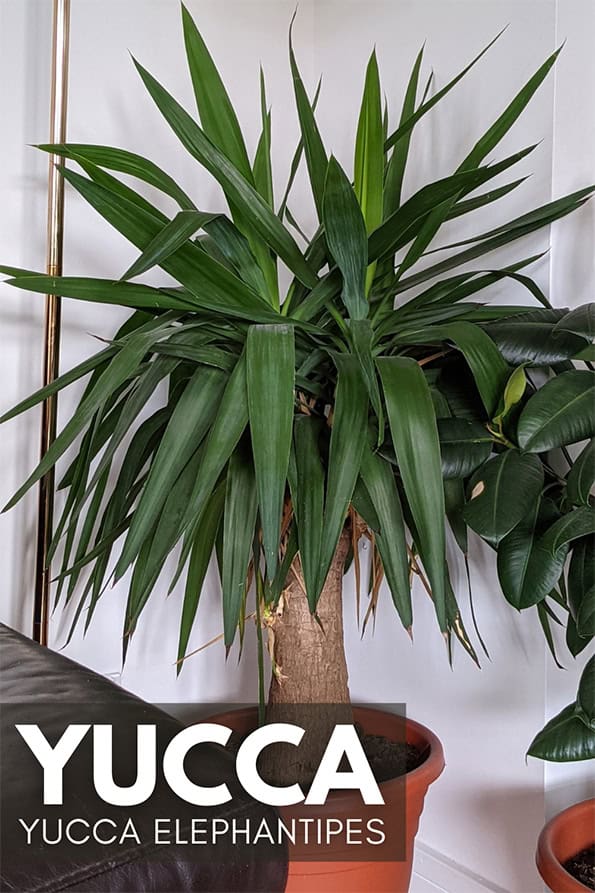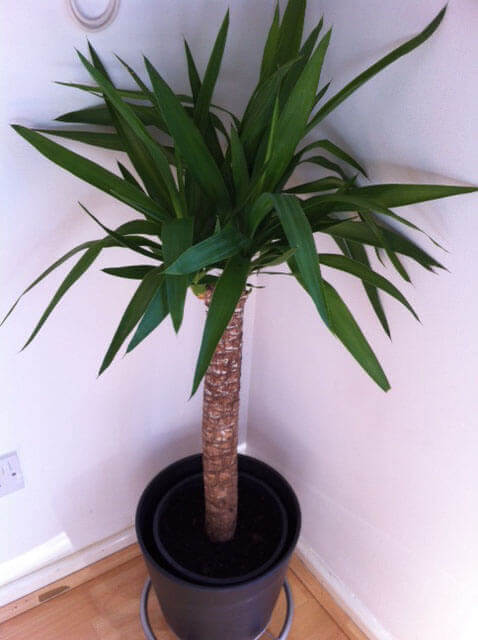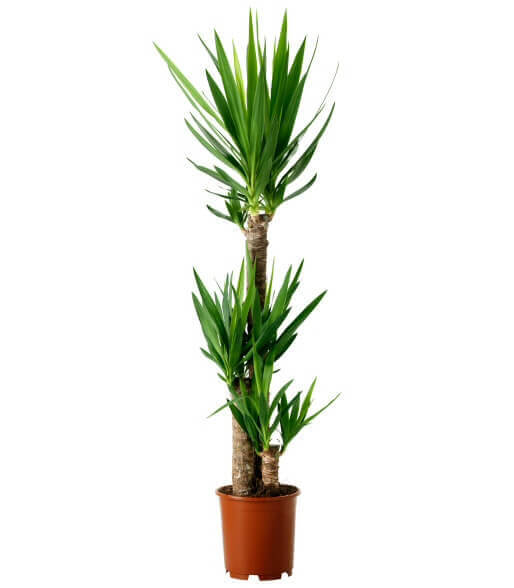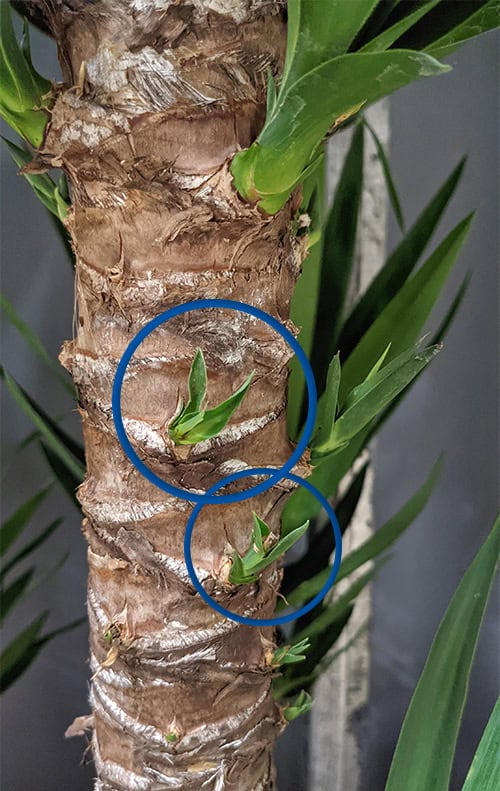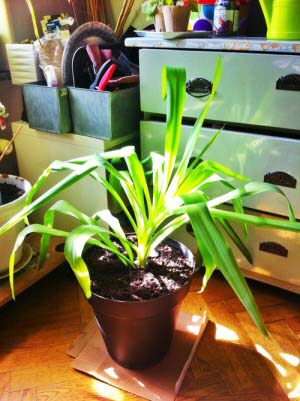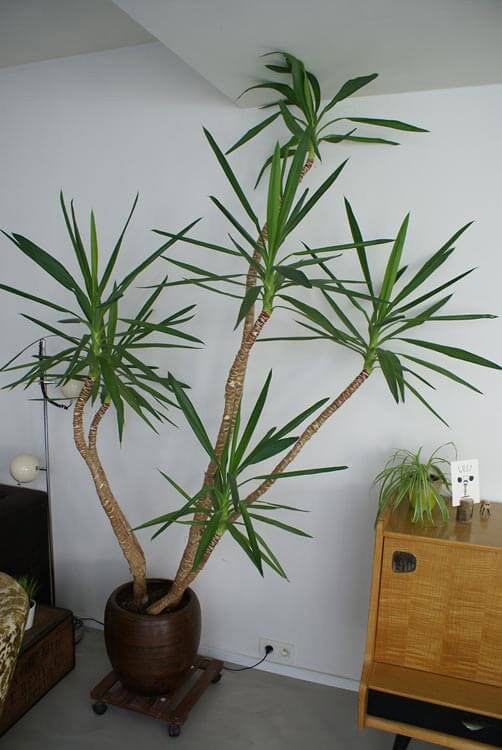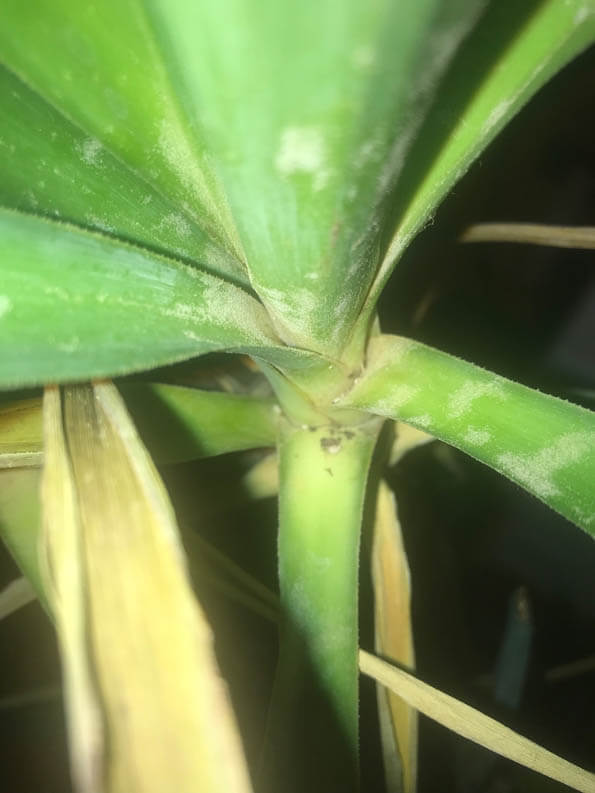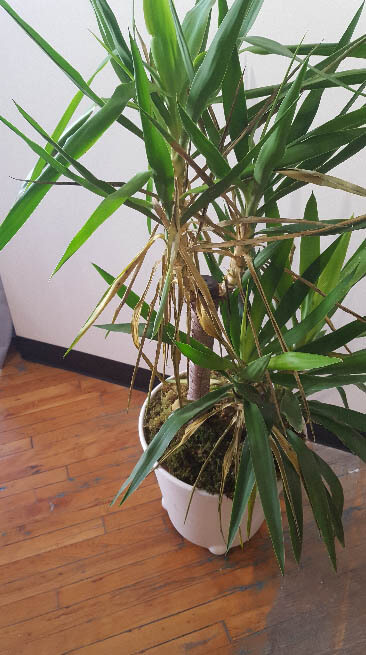Yucca's are both indoor and outdoor plants. When many people hear the word Yucca, they think about one of the many garden varieties that have dramatic clusters of white bell-like flowers during Summer. However it's also a popular modern houseplant.
A tall mature Yucca is bold and striking with straight angular edges. It looks very fitting in modern homes or when you want a stand-alone statement plant. Conversely, younger, smaller plants will still suit the majority of homes.
With it's easy going nature, attractive sword-like leaves and brown trunk a Yucca makes an excellent choice of you need a tall houseplant. There are several species of yucca, but only one makes for a suitable indoor plant.
Although all varieties are easy enough to grow, there is generally only one variety generally grown as an indoor plant these days and that is the "Spineless Yucca", "Yucca Cane" or "Stick Yucca". The Latin name on the labels should read Yucca gigantea or Yucca elephantipes (it's the same plant but goes by both names).
I would strongly advise giving any other type of Yucca a miss. And here's why.
Did You Know?
Although the Yucca has been grown as a houseplant for decades, it has only started to become popular as an indoor plant quite in the last 20 or so years. In fact if you have any old houseplant books lying around it's quite normal not to find it mentioned at all.
The nickname given to Yucca aloifolia for example, is "Spanish Bayonet". If that name isn't enough of a clue as to why it doesn't belong indoors, here in plain English is why you don't want it in your home - The leaves are razor sharp and end points on the leaves can pierce skin!
Accidentally brushing past the outdoor Yucca plants, grabbing its leaves, or leaning into it can be pretty painful to say the least. Although Yucca gigantea / Yucca elephantipes do still have saw like leaves and a sharpish leaf point, it's not as dangerous. This is why it has the common name of "Stick Yucca" and "Spineless Yucca".
Just to reiterate the leaves of the indoor Yucca while not overly sharp, still have a pointed end, so you should still take care when thinking about where to grow it.
The smaller, younger Yucca's (which would suit the majority of homes style wise) are relatively cheap, and easily found. The taller branched ones or containers containing multiple plants at different heights are considerably more in price and harder to get hold of.
It's common to buy a Yucca which has been grown from a special "log" or stem, after potting it up, the new green growth emerges out of the top of this trunk and the roots grow out of the bottom and into the soil. It can look a lot like a miniature palm tree, or in some cases a Dragon Tree (Dracaena).
The trunk can be slim and slender or be quite thick. The slimmer ones are the most common and least expensive, but the thick stemmed plants are highly attractive so they could still be worth looking for, but they will cost more. You can't grow a slim trunk into a thick one (or the other way around) so pick what you like best at the time of purchase.
The exposed trunk is certainly attractive by itself but a tall plant can lose its appeal by appearing "leggy", and this is why it's normal to find several Yucca's in a pot all of different sizes to negate this future "leggy" effect.
As they age, the leathery like leaves will arch downwards and will eventually yellow and fall off, replaced by the new top growth, this gradually increases the height of the plant.
Let's dive into the Care instructions, and if you follow them, they will help keep your Yucca in excellent condition and healthy for years to come.

Hi, I'm Tom!
If you're like me and enjoy the challenge of growing houseplants and getting them to thrive, then Ourhouseplants can help. This website shares my knowledge and years of growing plants and provides (hopefully) helpful advice on properly caring for your indoor plant friends.
The Yucca plant is one garden and houseplant which will be quite happy with as much sun as you can give it. Indoors a South facing window would be the first choice. Whatever your light situation try to provide as much as possible.
Indirect light will be acceted, but with less bright conditions growth will slow considerably (which may be an advantage) however very shady and dark spots must be avoided to maintain a healthy looking plant in the long term.
Water your Yucca liberally during warmer months of the year. Like all houseplants, it's impossible for me to give you fixed watering intervals, but if conditions are exceptional (bright, warm etc) you could be looking to do this as frequently as once a week or more.
You can wait until the the soil has full dried out (Yuccas have some drought tolerance) or just until the top inch of potting mix has dried out. The mix should contain mostly well-drained soil or something similar. It doesn't need to be excessively free draining, what's important is to avoid very dense and heavy soil.
It's important not to keep the mix constantly wet though as this can lead to overwatering problems and in some cases root rot or rotting of the trunk. In the Winter months this can be a common problem. Remember, a lot less water is required when it's cooler and there is less daylight around.
Moderate humidity will be helpful for keeping the leaves healthy looking. But these plants come from dry environments and can sometimes even grow as desert plants in their natural habitats. So most people won't need to apply humidity boosting things to be able to grow them well.
A feed once every month or two would be appreciated during the growing seasons.
You can use a normal houseplant feed or even one designed for garden plants. The below are two common examples and I've used both on my houseplants over the years, very happy to recommend either.
Your Yucca will tolerate a wide range of temperatures, but average home temperatures are best. Cooler in Winter if possible, but ideally not lower than 7°C (45°F).
They can cope with just below freezing temperatures but they're typically not as cold hardy as the outdoor Yucca's. So if you have them outside during the Summer, bring them back indoors before the winter cold sets in.
It's not essential, but a good rule of thumb is to repot every two years in Spring or Summer. The plants tend to become top heavy as most of the weight is centered at the top of the Yucca, planting in a deep heavy container will help prevent the plant from tipping over.
If you want to slow the growth of your plant don't repot it. One of my plants has been in the same container for almost 10 years. It's barely grown but still going. You can see this plant and hear me talk about my experience in my YouTube video linked a little further down.
There is a more complicated method of taking Yucca root cane cuttings. However, as I've not done this myself, I can't, with good faith, recommend it.
So if you want more plants, the easier method is to remove the offsets that are produced from the trunk and pot them up. You may also find suckers from around the base of the trunk. These can also be removed and potted up.
Healthy mature plants will often push out offshoots like these. They can be removed from the trunk and potted up as separate plants. Generally it's best to do it during the growing season as warm temperatures and light will encourage rooting.
The chances of the offsets growing will increase if you use a rooting hormone. Water well when first potting up, and then only again when the top inch of the soil has dried out. Constantly moist conditions will encourage rot.
The offsets should not be fed and kept out of direct sunlight until established.
Yucca's grow slowly. Growing it in a full sun location, a decent sized container and regular feeding will help, but this plant will still be a tortoise in the growth race, so don't expect miracles.
You can watch my Care Guide for the Yucca Plant over on YouTube.
Generally it is a narrow plant only spreading to around 50cm / 20in, however it can reach staggering heights of up to 4.5m / 15ft after many years.
The leaves will also get longer and arch out as it ages so the upper parts of the plant will form a wider canopy.
Normally sold as large plants here is an immature y. elephantipes that has been propagated from an offset. It's a slow grower though so it will take several years to get to this size.
A Yucca may produce flowers sometimes, although this is rare indoors. This plant is grown for its leaves and structural height rather than the flowers.
However, if conditions are good, similar sweet-smelling white bell flowers you see on outdoor Yucca may sometimes appear after several years.
The Yucca is moderately poisonous to cats, dogs and people. While it can normally protect itself through the sharp edges on the leaves and hard protective bark on it's trunk, if persistent pets or children damage the plant enough they'll come across the poisonous elements inside.
The wide sword shaped leaves are pretty tough, with a leathery texture. You won't be able to rip them with your fingers and while hardy greenery like this might please claw happy cat owners, they may enjoy using the bare "trunk" as a scratching post instead.
If the plant becomes too tall for the space then there is what I like to call the "leap of faith chop". This involves literally cutting / sawing a large top section of the plant off, usually in early Spring.
This results in nothing more than a fancy looking "log" or "stump" sticking out of the pot. However in a short time the plant should produce new growth shoots from the cut edge.
A tall branched Yucca could be the perfect choice for a living room centerpiece, although eventually it will run out of space. This one is touching the ceiling. Photo by Robin Berthier.
The top bit you have removed with all the leaves can be potted up in a different pot of potting mix as a separate plant. Make sure you firm it in well to prevent it falling or rocking itself out of the planter.
The stump needs to re sprout new leaves, the upper part you've removed needs to grow new roots, however in both instances regrowth is highly probable (but never certain). Some readers have tried it and you can read their comments at the end of this article.
This feels like the tongue-in-cheek moment where I need to add a disclaimer about being unable to take responsibility if your favorite houseplant is ruined. In all seriousness, once you hack your beloved Yucca to bits you can't go back. There is a chance you will lose both "parts" of your plant so you should only go ahead if you are prepared for that. Hence the leap of faith.
Bright Light This houseplant always performs best if given direct sunlight for at least several hours a day.
Average Watering These are hardy plants and it's difficult to over or underwater them. Aim to keep the soil either just moist during Summer or let it dry out but water it again as soon as it's fully dry. Much less water is needed in Winter when the plant is resting.
Average Temperature If you find the temperature comfortable, your plant will too.
Feeding Provide feed once very month or every other month whenever temperatures are warm and light levels good. You can cut back or stop feeding during Winter.
Leaf spots / Leaf disfiguration.
This can be caused by Leaf Spot. Remove badly affected leaves and spray with a fungicide. It can also be caused by poor air quality, particularly if the humidity is very high, or if exposed to temperatures below 7°C / 45°F for prolonged periods. The plant can deal with cooler temperates but the leaves can look less pristine.
White Film on the leaves.
This problem keeps coming up in the comments below as well in direct emails. The photo below shows a good example.
White film like this on a Yucca houseplant, can be caused by Fungal Diseases or pests like Scale insects. Photo shared by Laura Davidson.
In almost all cases it's going to be caused by one of the following.
So what's wrong with the plant in the photo above? The owner shared several photos, some clearly showed the natural white marks, so parts of the plant were fine and didn't need any treatment.
However if you look closely you can see the white film is in spots and individual blotches. There are also black and brown dots in the creases of the leaves where they meet the stem, which isn't normal. So in this instance the Yucca has a pest infestation that needs to be treated accordingly.
Yucca leaves bending over / Wilting.
This is one of the hardest problems to identity and resolve because it could caused by any number of things. Firstly some Yuccas will have this trait naturally (see gallery photos). If it comes on suddenly, it could be caused by poor watering techniques (over or under-watering). Shock, after moving or repotting the plant. Too much fertiliser.
Even if you restore conditions to what they were previously it may not be enough. Yucca's are often difficult to bring back to health once they start to go downhill, so if it does succumb it might make you feel better to know you are in good company.
Completely yellow or brown leaves.
If you are pretty good with houseplants this will be rare, however these symptoms are usually caused by extreme underwatering.
Further reading -
How often should I water my plants?
Lower leaves yellowing.
If the oldest leaves are going yellow then this is normal and not a concern. The plant will produce new leaves over time but the oldest ones go over. They don't usually fall off by themselves so you may need to get in there and sort them out. I cover this in the next problem coming up below.
Tatty looking plant.
Yucca's have fairly long and thick leaves, so if any of the leaves are looking brown or messy it can create a real eyesore as well as making it look like a problem exists when there isn't one.
A Yucca with brown leaves making the plant look tatty and ugly - Photo shared by Debbie Zhalkovsky.
The leaves are thick and tough and even when they go over they don't fall off the plant nicely, instead they sort of hang there like the plant in the photo here.
To restore things to its former attractive appearance you will need to get in there and gently but firmly pull the brown leaves directly downwards towards the floor. They should "rip" off the trunk / stem with no visible damage. It's very simple but effective and will transform the look of your plant.
If you're having problems removing any of the leaves then simply cut them off as close to the trunk and stem as possible.
Brown Tips with yellow rings or halos.
Usually a sign of constant overwatering. Ensure the soil dries out before you water again, and drain out any excess liquid left in the pot / drip tray after half an hour.
Brown leaf tips.
Very low humidity is the typical cause, however it can also be a symptom of the previous problem.
Credit for the Shower picture in gallery - Prada Panda
Credit for the recently potted up Yucca offset in the article - In My Plants
Credit for the tall Yucca touching the ceiling in the article / gallery - Robin Berthier
